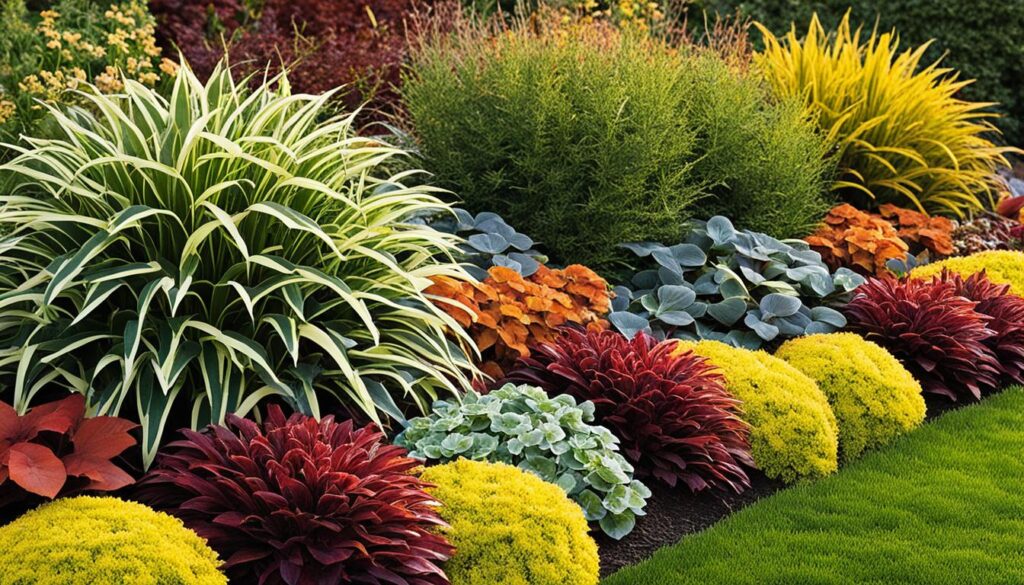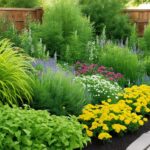Did you know some vegetable vines, like pumpkins, can grow up to 30 feet long1? As fall arrives, many think their gardens will fade with the summer heat. But, fall is a great time to add to your garden with plants that love the cooler weather. These plants can also make your cooking taste better. Let me show you how to grow fall vegetables that get sweeter after the first frost, like beets and carrots1. With the right care, your garden can stay colorful and full of life even in the cooler months.
Key Takeaways
- Embrace the versatility of fall as an ideal time for growing certain vegetables with improved flavor.
- Implement strategic gardening tips to extend your garden’s productivity through the fall.
- Explore plant care techniques that cater to the unique needs of fall plant varieties.
- Appreciate the diverse options for landscaping with aesthetically pleasing and edible outdoor plants.
- Understand how to improve garden design with plants that not only survive but thrive in cooler weather.
Fall Harvest Vegetables to Enrich Your Garden
Welcome to the exciting world of fall harvest vegetables. These plants bring vibrant colors and rich flavors to your garden and table. Gardening in autumn adds beauty to your garden and brings fresh, nutritious food to your meals.
The Rich Palette of Pumpkins
Pumpkins are a symbol of autumn. They come in many sizes and colors, from big orange ones to unique white or speckled ones. These plants add color to your garden and have many uses. Some are for decoration, while others, like ‘Baby Pam’ and ‘Long Pie’, are great for cooking.
Winter Squashes: A Bounty of Options
Winter squashes like acorn, spaghetti, and butternut are key for fall gardens. They can be stored for months, offering a steady supply of food. Growing them vertically saves space and adds beauty with their vines and fruits.
Sweet Beets and Carrots for Cooler Days
Beets and carrots are perfect for the cooler fall days. They grow well in the fall and taste sweeter then. You can plant them from late spring to summer for a long harvest into fall. They add rich flavors and color to your meals.
- Lettuce varieties like Romaine and Butterhead are great for fall, offering crisp leaves for salads2.
- Carrots need loose, sandy soil and should be planted deep for their growth3.
- Beets add a deep red color to your garden and provide a steady supply of tasty roots3.
- Using natural pest repellents like marigolds and garlic can cut down on chemical pesticides2.
Starting a fall garden brings a season of growth and a long harvest. By picking the right plants, you can make your garden both productive and magical.
Planting Techniques for a Thriving Fall Garden
When the fall season comes, I think about the great chances it offers for my garden. The cooler weather means fewer pests and less watering, making it perfect for fall crops4.
One important tip I’ve learned is about timing. It’s key to plant seeds before the first frost. For example, Brussels sprouts and kale taste better after a frost, making them great for late planting4. Planting at the right time helps broccoli and carrots grow well4.
- Get your soil ready with compost or Miracle-Gro® Garden Soil for Vegetables & Herbs for better growth4.
- Plant perennials like asparagus and strawberries for future harvests in the cooler weather4.
- Use succession planting and mulching to keep plants going in milder climates4.
Choosing the right plant varieties is crucial for a good fall harvest. Using Bonnie Plants® in rich soil and feeding them Miracle-Gro® Shake ‘n Feed® can triple your harvest4.
| Vegetable | Days to Maturity | Planting Date (Example) |
|---|---|---|
| ‘French Breakfast’ Radishes | 25 days | September 225 |
| Spinach | 40 days | September 75 |
| Kale | 55 days | August 235 |
Using planting techniques like strategic placement and considering sunlight patterns helps plants last through the shorter days. Some veggies do well in the shade, perfect for the garden’s darker spots4.
Using organic foods and watering plants deeply once a week helps them grow strong and extends the gardening season. I make sure each plant gets an inch of water, mimicking natural rainfall, which encourages deep roots5.
To keep my plants safe from early frosts, I cover them with row covers or even blankets. This keeps them warm and can make them last into winter5.

Enhancing Flavor and Health with Brussels Sprouts and Broccoli
I love gardening and find fall crops like Brussels sprouts and broccoli fascinating. They add color and texture to my garden. Plus, they’re packed with nutrients that are good for my family’s health. Growing these veggies turns my fall garden into a lush, fruitful space.
Brussels Sprouts: Gardening Tips for the Last Veggie Standing
Brussels sprouts are great for winter gardens, staying in the ground as long as it’s above 20°F6. They do best in soil with a pH of 6 to 76. Plant them 18 inches apart to let them grow big6. Water them well, but make sure the soil isn’t too wet, to help them grow strong6.
Using companion planting can help fight off pests. Marigolds and nasturtiums near Brussels sprouts keep away flea beetles and aphids6. This method cuts down on the need for harmful chemicals, making your garden healthier.
Broccoli: Late Summer Start for a Hardy Harvest
I plant broccoli in late summer to beat the early frosts. This way, they get to grow strong and taste better. Broccoli also adds a beautiful green touch to my garden, perfect for autumn.
Adding broccoli and Brussels sprouts to meals like the ‘Roasted Brussels Sprouts and Broccoli Bean Bowl’ is great. It’s affordable, costing about $4 per serving7, and full of protein, with 15 grams in a 2-cup serving7. These veggies are versatile and offer many health benefits.
Using these tips can make your gardening better, leading to a great fall garden. Growing Brussels sprouts and broccoli is rewarding, whether you care about their looks or their health perks.
The Short-Cycle Success of Bush Beans and Spinach
Bush beans and spinach are great for cooler weather gardens. They grow fast and add color in the fall. These plants love the cooler days, making the most of the long season for multiple plantings8.
For gardeners, knowing how to care for bush beans is key. They start growing well at soil temperatures of about 77°F. They also make the soil richer by adding nitrogen in root nodules9. To keep getting fresh beans, plant seeds every 20 days for a steady harvest9.
Spinach loves the cool fall weather and can even handle a bit of frost. You can plant it every two weeks for a constant supply of fresh greens8. It also makes your garden look great with its bright colors.
Using a rotation system helps your plants grow better and gives you more produce. This means not planting the same crops in the same spot for three years. It fights diseases and keeps the soil fertile8.
Bush beans and spinach are top picks for gardeners wanting a quick and bountiful harvest. With proper care and planting at the right times, you can enjoy a full fall season of fresh produce.
In summary, growing bush beans and spinach is a smart move for your garden. They bring life to your garden in cooler months and keep the soil healthy. They’re key for a diverse and sustainable garden.
Garden Plants That Make a Comeback in the Fall
As summer’s colors start to fade, many gardeners think their growing season is ending. But fall offers a chance to refresh our gardens with plants that come back strong. Choosing the right plants and taking good care of them is key to a great autumn garden.
Rapid Growth Varieties to Consider
In fall, quick-growing plants are great for a new start. Snow peas and snap peas grow about 4 inches tall and come back after winter10. Also, annuals like petunias, snapdragons, and bachelor buttons are easy to care for and brighten the garden with little work10. These plants come back on their own, making your garden look good with less effort.
Calculating Growing Times for Optimal Fall Harvest
Planning is key for a fall harvest. Plants like radishes, beets, and turnips grow well in the fall, taking less than two months to mature11. Knowing this helps you take better care of your plants, making sure they bloom at their best.
For bulbs that bloom in spring, plant them from early fall to late November. Tulips and daffodils should be planted with the pointed end up, about three times their size deep, for a beautiful spring show11.
| Plant Type | Ideal Planting Time | Maturity Length |
|---|---|---|
| Snap Peas | Early Fall | Approx. 1-2 months |
| Radishes | Mid Fall | Less than 2 months |
| Tulips | Late Fall | Will bloom in Spring |
By following these tips and planning your growing times, your garden will come alive even in the cooler months. Let’s make the most of fall in our gardens, creating a beautiful mix of colors and textures all year.
Autumnal Herbs: Flavors for Your Fall Kitchen
Welcome to the vibrant world of autumnal herbs, key garden plants that boost your fall cooking and grow well with vegetables in the cool months. These herbs are not just for flavor; they support sustainable plant care and adapt to the seasons. Let’s look at some important herbs and how to care for them.
Top herbs for your garden include Coriander, Chervil, Fennel, Mint, Oregano, Parsley, Rosemary, Sage, and Thyme. These plant varieties create a strong planting system. They help keep your garden healthy by keeping pests away and improving soil health. The mild autumn weather is perfect for planting these herbs since the soil is warm and pests like the carrot fly are fewer1213.

Autumn is also a key time for plant care. It’s important to water them less and get ready for cold nights. Some herbs need protection from frost, like covering them with fleece or moving them indoors12.
If you want to make your holiday meals special, plant mint before Christmas. It will give you fresh mint for your dishes during the holidays12. Herbs like rosemary and oregano grow well in the cool season in Central Texas, making them great for winter gardens13.
When adding to your garden plants, remember to plant autumnal herbs from October to mid-December in places like Central Texas13. This is a great time to start a beautiful and fragrant garden.
In conclusion, growing autumnal herbs does more than give you fresh spices. It includes caring for the soil, managing pests, and adapting to the seasons. So, why not make your garden and kitchen more exciting this fall with some aromatic herbs?
Designing Your Fall Landscape with Outdoor Plants
Fall is a great time to update your landscaping. Use vibrant colors, smart garden design, and good plant care. This season’s unique weather lets you mix beauty with practicality. Your garden can become a beautiful escape.
Additional Plant Species to Consider
Adding plants like conifers and Japanese maples adds texture and structure to your garden. These plants come in many shapes and colors, making your garden interesting14. ‘Blue Ice’ bluestar adds color and blends well with other plants, creating a unified look14. This mix boosts your garden’s beauty and supports a healthy ecosystem.
Companion Planting for a Harmonious Garden
Companion planting is key for a balanced garden. Pairing plants that grow well together and need similar nutrients makes for a healthier garden. For example, planting ornamental kale and cabbage with pansies creates a beautiful mix of colors15. These plants help each other grow, keeping your garden looking great into the cold months.
Plants started in the fall do better because their roots are stronger16. This is important for garden design. Strong roots mean your plants will show off their colors and textures well.
Adding things like rusted metal or gray granite can make your garden more interesting14. These elements add visual appeal and help your garden look unified. They show how creativity in design makes your garden beautiful.
Your fall landscaping can show off the season’s beauty with vibrant colors and careful planning. Choosing the right plants and design makes your garden a work of art. It brings joy and practical benefits, making every view special.
Prepping for Post-Summer: Fall Garden Plant Care
As I switch to cozy sweaters, my garden changes too. It gets ready for the cooler weather with special tips and tricks. Before enjoying autumn’s leaves and cool breezes, I start preparing my plants. Fall is the perfect time to add new plants to the garden.
Since daylight hours are shorter, I add a week or two to the growing time for fall veggies17. This helps my garden stay beautiful and full of life. I also watch out for slugs and cutworms, keeping my plants safe17.
Last year, gardens in Virginia did well thanks to more rain and cooler weather18. I’m planning to improve my soil for spring by using cover crops now. This method boosts nutrients and soil health, keeping my garden vibrant18. I plant seeds in the fall, making sure they get enough water, about an inch a week, for strong growth17.
Now is the best time to plant pansies, mums, and kale for a colorful garden19. To protect my plants from frost, I’ll use mulch, and maybe cloches or move containers19. With careful planning, I ensure a smooth transition into the new season, ready for a beautiful garden.
Gardening is not just luck; it’s about understanding the soil and listening to nature’s signs1719. I write down my gardening tips to help others and myself for future success.
FAQ
What plants are ideal for a fall garden design?
When should I start planting my fall harvest vegetables?
How do I maintain soil health for my fall garden plants?
Can I plant bush beans and spinach in my fall garden?
Which herbs grow well in the fall?
How can I use companion planting in my fall garden?
What gardening tips can you provide for caring for outdoor plants post-summer?
How do I manage pests in the fall garden?
Are there any specific plant varieties that are fast-maturing for a fall garden?
Source Links
- 15 Fall Vegetables to Plant in Your Garden – Garden Design – https://www.gardendesign.com/vegetables/fall.html
- Fall Vegetables for Gardening: 20 delicious suggestions – https://heirloompotager.com/fall-vegetables-for-garden/
- 18 Fall Vegetables To Plant Now For A Fall Harvest – https://www.southernliving.com/garden/grow-fall-vegetables
- Fall Garden Planting & Planning | Bonnie Plants – https://bonnieplants.com/blogs/garden-fundamentals/how-to-plant-a-fall-garden
- Here’s How to Plant Fall Garden Vegetables in Summer – https://www.bhg.com/gardening/vegetable/vegetables/fall-vegetable-gardening/
- Growing Brussels sprouts in home gardens – https://extension.umn.edu/vegetables/growing-brussels-sprouts
- Roasted Brussels Sprouts and Broccoli Bean Bowl – https://moretimeatthetable.com/2023/01/12/roasted-brussels-sprouts-and-broccoli-bean-bowl/
- Succession in the Garden – https://www.grocery.coop/article/succession-garden
- succession planting for months of green beans – https://growingformarket.com/articles/succession-planting-for-months-of-green-beans
- Annuals Make A Comeback – https://www.gardeningknowhow.com/backyard-stories/annuals-coming-back
- What to Plant in the Fall – Garden Design – https://www.gardendesign.com/autumn/planting.html
- Autumn in Jekka’s Herb Garden – https://www.jekkas.com/blogs/jekkas-blog/autumn-in-jekkas-herb-garden?srsltid=AfmBOop8Esk1sbNmbhgOwhb4zfheCvzf9Ck3U7Ci4PHyC8h7aEK8hROE
- Autumn-Season Herbs – https://www.texasgardener.com/autumn-season-herbs/
- A Garden Design With Lots of Hardscape and Plants – Fine Gardening – https://www.finegardening.com/article/a-garden-design-with-lots-of-hardscape-and-plants
- Make Your Fall Landscaping Pop with Seasonal Color – Horizon Landscape – https://www.horizonlandscape.com/fall-plantings-seasonal-color/
- 10 Ideas to Liven Up Your Landscaping This Fall | brick&batten – https://www.brickandbatten.com/10-ideas-to-liven-up-your-landscaping-this-fall/
- Preparing Your Vegetable Garden for Fall – Fine Gardening – https://www.finegardening.com/project-guides/fruits-and-vegetables/preparing-your-garden-for-fall
- Prepping Your Garden for The Next Growing Season – https://gardenprofessors.com/prepping-your-garden-for-the-next-growing-season/
- Prepare Your Garden for the Fall Season Transition – https://shiplapandshells.com/transition-garden-from-summer-to-fall/


